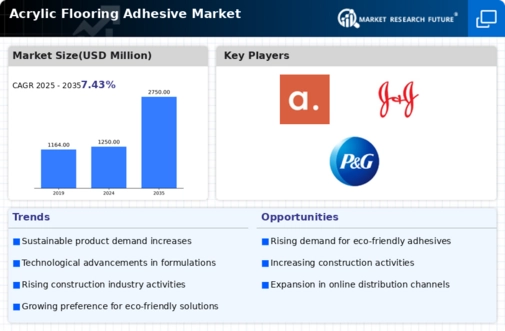Market Growth Projections
The Global Acrylic Flooring Adhesive Market Industry is projected to experience substantial growth, with a compound annual growth rate of 7.43% anticipated from 2025 to 2035. This growth trajectory is indicative of the increasing adoption of acrylic adhesives across various sectors, including construction, automotive, and manufacturing. The market's expansion is supported by rising consumer preferences for high-performance flooring solutions and the ongoing development of innovative adhesive technologies. As the industry evolves, it is expected to adapt to changing market dynamics and consumer demands.
Expansion of the Retail and E-commerce Sector
The expansion of the retail and e-commerce sector is contributing to the growth of the Global Acrylic Flooring Adhesive Market Industry. With the rise of online shopping, there is an increasing need for efficient logistics and warehousing solutions, which often require durable flooring. Retailers are investing in high-quality flooring systems that utilize acrylic adhesives for their superior performance. This trend is expected to continue, with projections indicating that the market could reach 2750 USD Million by 2035, driven by the ongoing growth of e-commerce and retail spaces.
Growth in Construction and Renovation Activities
The Global Acrylic Flooring Adhesive Market Industry is experiencing growth due to a surge in construction and renovation activities worldwide. Urbanization and population growth are contributing to increased demand for residential and commercial spaces. In 2024, the market is valued at approximately 1250 USD Million, reflecting the robust construction sector's reliance on high-performance adhesives. As new buildings emerge and existing structures undergo renovations, the need for durable and effective flooring solutions becomes paramount, thereby driving the demand for acrylic adhesives.
Rising Demand for Sustainable Flooring Solutions
The increasing emphasis on sustainability is driving the Global Acrylic Flooring Adhesive Market Industry. Consumers and businesses alike are seeking eco-friendly flooring options that minimize environmental impact. Acrylic adhesives, known for their low volatile organic compound emissions, align with these preferences. As a result, manufacturers are innovating to produce adhesives that not only meet performance standards but also adhere to environmental regulations. This shift is likely to enhance market growth, as the demand for sustainable solutions is projected to rise significantly in the coming years.
Increasing Awareness of Health and Safety Standards
Increasing awareness of health and safety standards is shaping the Global Acrylic Flooring Adhesive Market Industry. As regulations surrounding indoor air quality and worker safety become more stringent, there is a growing preference for adhesives that comply with these standards. Acrylic adhesives, with their low emissions and non-toxic properties, are becoming the preferred choice for many applications. This trend is likely to drive market growth as industries prioritize health and safety in their operations, thereby increasing the demand for compliant adhesive solutions.
Technological Advancements in Adhesive Formulations
Technological advancements in adhesive formulations are significantly influencing the Global Acrylic Flooring Adhesive Market Industry. Innovations in polymer chemistry have led to the development of adhesives with enhanced bonding properties, faster curing times, and improved resistance to moisture and temperature fluctuations. These advancements not only improve the performance of acrylic adhesives but also expand their application range across various flooring types. As manufacturers continue to invest in research and development, the market is likely to witness a surge in demand for these advanced adhesive solutions.













